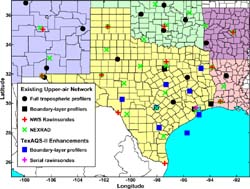Texas Air Quality Study (TexAQS) -
Gulf of America Atmospheric Composition and Climate Study (GoMACCS)
2005-2006 Field Program

|
In 2006 NOAA will help lead a major multi-institutional intensive field program that will focus on investigating important scientific questions that are common to both climate and air quality. The NOAA components of the program are the Texas Air Quality Study (TEXAQS) and the Gulf of Mexico Atmospheric Composition and Climate Study (GoMACCS). This intensive field study will focus on providing a better understanding of the sources and atmospheric processes responsible for the formation and distribution of ozone and aerosols in the atmosphere and the influence that these species have on the radiative forcing of climate regionally and globally, as well as, their impact on human health and regional haze. The study area will be Texas and the northwestern Gulf of America.
ETL contributes to these efforts through observations and measurements of the atmosphere, land and ocean surface; through analysis of meteorological processes influencing the formation of ozone and aerosols; and by evaluating numerical air quality models.
Transport and Mixing
Regional air quality and climate in Texas and the Gulf of America are highly dependent on the transport and mixing of trace gases and aerosol particles. These processes occur on a variety of spatial scales, including atmospheric boundary layer (ABL), regional, intra-continental, and intercontinental. The 2006 study will examine the full range of transport scales and their influence on regional air quality and climate in Texas. A clear understanding of transport on these scales will allow us to assess the impact from local, regional, and distant sources on the air quality of air masses as they impact Texas or are exported to downwind locations.
This study seeks to answer questions such as:- How do the heating and cooling cycle at the earth's surface affect horizontal transport from the major sources?
- Under what conditions does local urban pollution have a significant impact on other areas in the region?
- How effective are transport and vertical mixing in dispersing pollution from the major sources into the surrounding region?
- Are fugitive emissions from oil production important for regional pollution episodes?
- Do specific areas in Texas represent a source of pollution to other areas of the United States?
- How do elevated background concentrations imported from distant sources outside of Texas impact air quality or climate in the state?
Approach
NOAA researchers and collaborators will address transport and mixing questions with an array of instrumentation.Surface Network
Vertical profiles of wind and temperature, plus mixing height, will be provided by a network of surface-based radar wind profilers with RASS, serial rawinsonde ascents, and a Doppler lidar, which will measure the fine-scale structure of the boundary layer either on the ship or at a land site.
Airborne DIAL Lidar
NOAA airborne ozone DIAL will provide important information on the vertical and horizontal distribution of pollutants for forecast and model verification.
R/V Brown Shipborne Observations
The R/V Ronald H. Brown will carry surface-flux and energy-balance measurement capability, a Doppler wind profiler, an O3 profiling lidar, a sophisticated complement of air chemistry sensors, and other instrumentation.
Numerical Modeling Evaluation
The cross-evaluation of several air quality forecast models is an important aspect of the 2006 evaluation study. There are fundamental differences in the basic formulation and meteorological foundations of the current operational and research air quality forecast models. The effect these different model formulations have on Texas air quality predictions justifies a detailed statistical evaluation between the various models.
Model evaluation studies for aerosols and the precursors for aerosol and ozone are severely limited by a lack of data both aloft and at the surface. The 2006 study is unique in that it will provide a glimpse of both the gas-phase oxidant component of air quality (i.e. ozone) and the particulate-phase components (i.e. PM2.5 and PM10 aerosol) over a large horizontal and vertical extent of Texas. This data set will therefore represent the centerpiece not only for model evaluation of ozone and its precursors, but for aerosols and visibility in Texas as well.